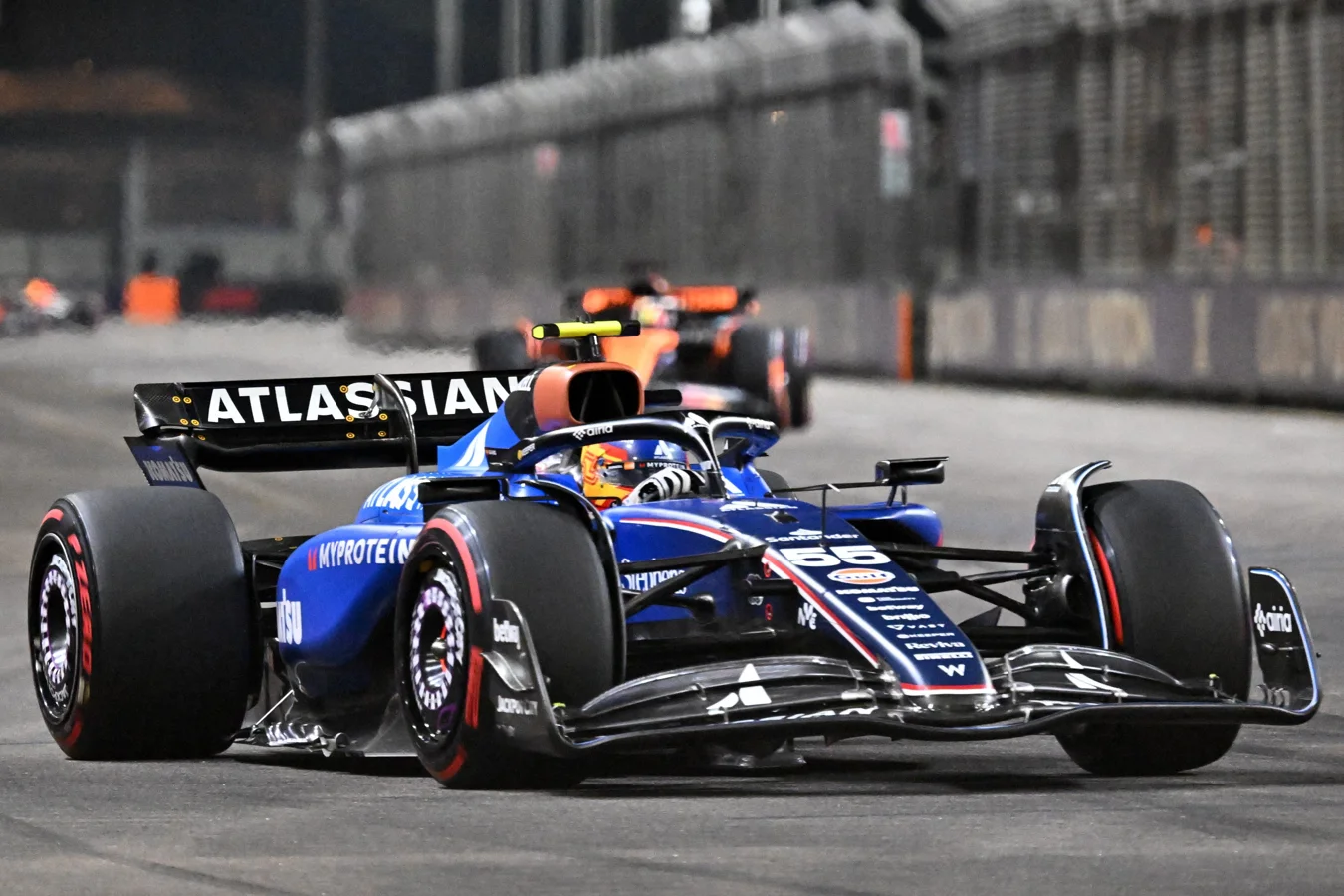Williams drivers Carlos Sainz and Alex Albon face potential disqualification from the Singapore GP qualifying session after their FW47 cars were found to breach FIA regulations concerning the allowed DRS gap size. This incident emerged during the lead-up to Sunday’s race at Singapore’s night circuit as officials reviewed the rear wing measurements for compliance.
The recurring issue of rear wing infractions has cast a shadow over recent Formula 1 weekends. Following Esteban Ocon’s disqualification due to similar violations at the Azerbaijan GP, the Williams duo may now suffer the consequences of an identical technical infringement. The FIA’s strict technical directives mandate a maximum gap of 85 millimeters between the main plane and the movable upper flap of the rear wing when the DRS (Drag Reduction System) is active.
Measurements revealed that both Williams cars exceeded this gap limit, prompting FIA stewards to consider invalidating their qualifying times. The precedent for such penalty includes Lewis Hamilton’s disqualification from the 2021 Brazilian GP qualifying after a rear wing regulation breach, although he ultimately recovered to win the race. Whether Williams can replicate such success remains uncertain, highlighting the high stakes associated with these technical checks.
Carlos Sainz’s Ambitions Despite Regulatory Challenges at Singapore
Coming off his first career podium at the Azerbaijan GP, Carlos Sainz is eager to maintain momentum in Singapore despite the looming threat of disqualification. The Grove-based team is aiming to move past the setback and concentrate on the upcoming race efforts under the challenges of night racing.

Reflecting on his difficulties during qualifying, Sainz shared his thoughts to The Best F1 regarding the car’s unexpected performance issues:
“Since qualifying began, it seemed like we were going slower than the rest of the weekend. We had to change several things on the car that didn’t seem to work and didn’t help. Even so, it’s very difficult to understand, and it’s happened to us more than once this year, when we struggled more with the tires in qualifying than in free practice.”
— Carlos Sainz, Williams Driver
“Today, I didn’t feel it was just the tires; I simply didn’t have the rear-end grip, and that affected us, especially in the final sector. Yesterday, it was purple in free practice, and today it was difficult for us. Things will surely happen tomorrow. I’m going to try to make progress, and I’m sure we’ll have a fast car tomorrow, but the key is to overtake, which is complicated, but we’ll see if we can do something with our strategy.”
— Carlos Sainz, Williams Driver
Currently holding 12th place in the drivers’ standings, Sainz is determined to improve his position in the final portion of the 2025 Formula 1 season, though the technical infringement issue complicates his weekend prospects.
Context of Rear Wing Regulations and Their Impact on Race Weekend
The FIA’s regulation on rear wing flexibility and DRS activation reflects ongoing efforts to ensure fair competition and safety in Formula 1. The movable flap on the rear wing reduces aerodynamic drag when open, providing higher speeds. However, the gap between the wing’s main plane and the flap cannot exceed 85mm once the DRS is engaged to curb excessive performance gains.
In the case of Williams’ FW47 cars, exceeding this threshold not only violates the technical rules but also risks the disqualification of the times recorded during qualifying sessions. This results in drivers being relegated to starting lower on the grid or, in some scenarios, excluded from qualifying results entirely.
Williams faces intensified scrutiny following the Azerbaijan GP’s penalties involving Esteban Ocon and others, signaling a tightening regulatory environment. These actions affect team morale and strategy, often forcing crews to rethink car setup and aero packages amid unfolding race weekend pressures.
Implications for Williams and the Singapore Grand Prix
The disqualification risk hangs heavily over Williams’ race strategy at Singapore, where track position and overtaking are notoriously challenging. A qualifying setback could force Sainz and Albon to start deeper in the field, where gaining positions under Singapore’s intense night race conditions will be complicated.
The Singapore GP has historically been a venue where teams’ technical compliance matters greatly due to the circuit’s tight layout and technical demands. Failure to comply with the DRS gap limit not only hurts qualifying ambitions but can also undermine race-day competitiveness.
Moving forward, the Williams team will need to address the technical scrutiny thoroughly, ensuring their FW47’s aero setup aligns strictly with FIA rules to avoid further penalties. For Sainz and Albon, the challenge will be to maximize race pace and overtaking strategies to recover lost ground should disqualification occur. This will test both driver skill and team adaptability under pressure.
